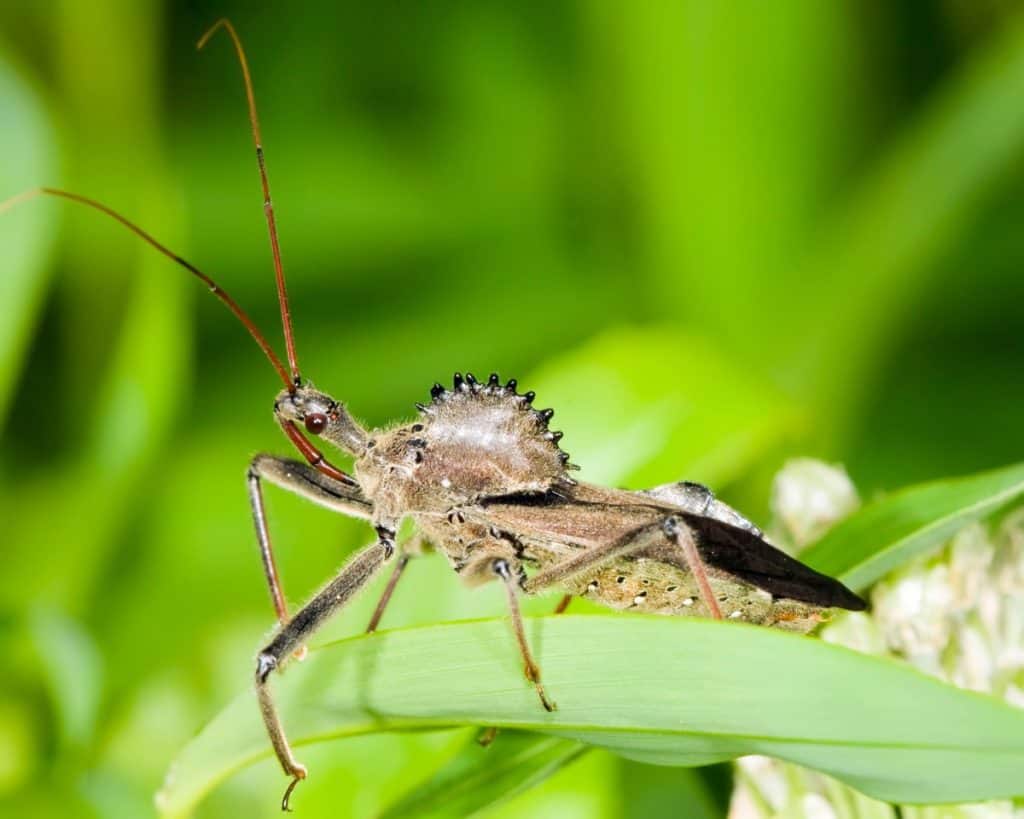
posts and pages could include affiliate links which may result in earnings for the site. As an amazon associate, we earn from qualified purchases.
Although wheel bugs are not dangerous and can actually help your garden, many wish to still get rid of them. This is because of their frightening appearance. So, if you want to, how do you get rid of wheel bugs?
To get rid of wheel bugs, eliminate the insects they consume: beetles, caterpillars, honey bees, and moths. Do not kill wheel bugs, as they are beneficial to a garden’s ecosystem. Rather, eradicate the insects they prey upon, and they will leave if they no longer have an abundant food source.
However, if you do not feel threatened by the wheel bugs in your yard, then you may want to consider keeping them, as they will keep away the harmful insects. By continuing to read below, you will discover everything you could ever want to know about wheel bugs and how to get rid of them.
Are Wheel Bugs Dangerous?
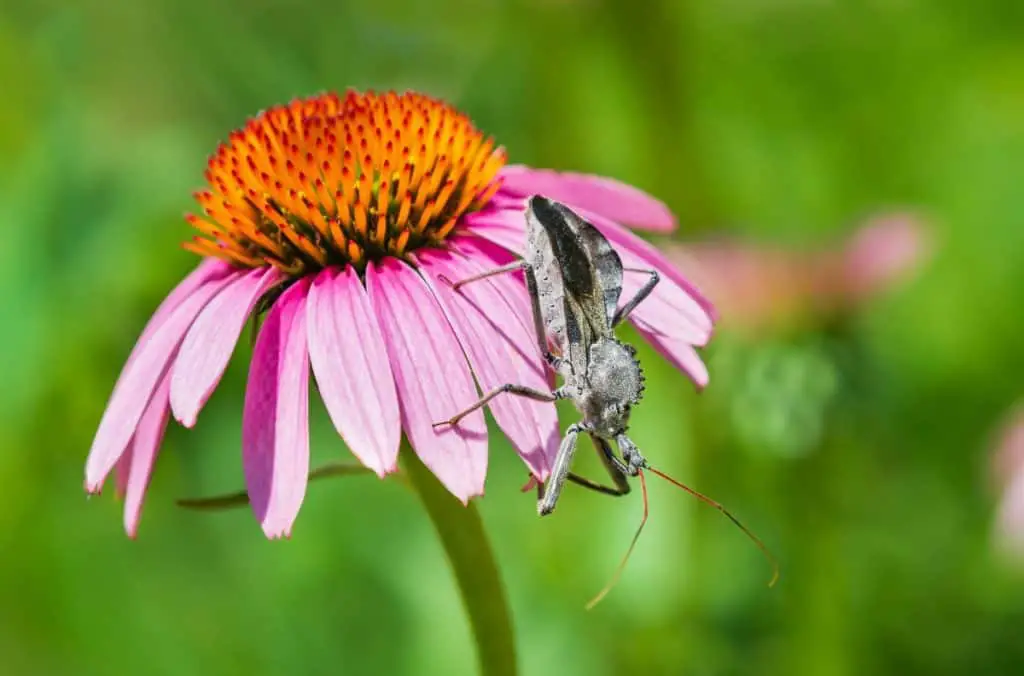
For those who have never before seen a wheel bug, they can initially seem very intimidating. They are a species of assassin bug, which makes others fear them even more. Being a part of an assassin family can seem threatening and even innately aggressive. However, are wheel bugs actually dangerous?
Wheel bugs are not dangerous. They will try and avoid contact with humans at all costs. They are not aggressive and will not initiate any sort of attack. If handled recklessly, however, the wheel bug will bite. Wheel bugs will act out in self-defense if they feel threatened.
Many individuals mistreat wheel bugs and then are shocked when they bite. Wheel bugs should only be handled with care, otherwise, their method for obtaining safety may be misunderstood as aggression.
Wheel bug bites are painful but are not normally harmful. Those who have been bitten by a wheel bug report feelings of immense pain. This pain lasts for a few minutes and then begins to die down. Wash the affected area immediately to cleanse it. If you start to have an adverse reaction, seek medical attention.
In January of 2002, Richard Fagerlund wrote a column for the San Francisco Gate. In this column, he mentions that he has been bitten by almost everything imaginable.
“Over the years I have been bitten by venomous snakes nine times… I have been stung by a half dozen scorpions, several centipedes, a black widow and several other spiders, fire ants, harvester ants, velvet ants (wingless wasps), bats, rats and cats.”
Source
Despite all of the vicious things he has been bitten by, Fagerlund acknowledges the bite of the wheel bug as the worst of them all. Although the bite of the wheel bug is not dangerous, it is intense. Fagerlund believes it feels as though you are being shot, and he has been shot before. His pain lasted for days, although it was not as intense the longer it went on.
Although wheel bug bites are not dangerous and will not kill a human, they are clearly very painful—the kind of pain that many find unbearable. If you come into contact with a wheel bug, chances are it will not bite, as it will try and avoid you. However, you do not want to intimidate it in any way. The wheel bug will strike if it is provoked.
Should You Kill Wheel Bugs?
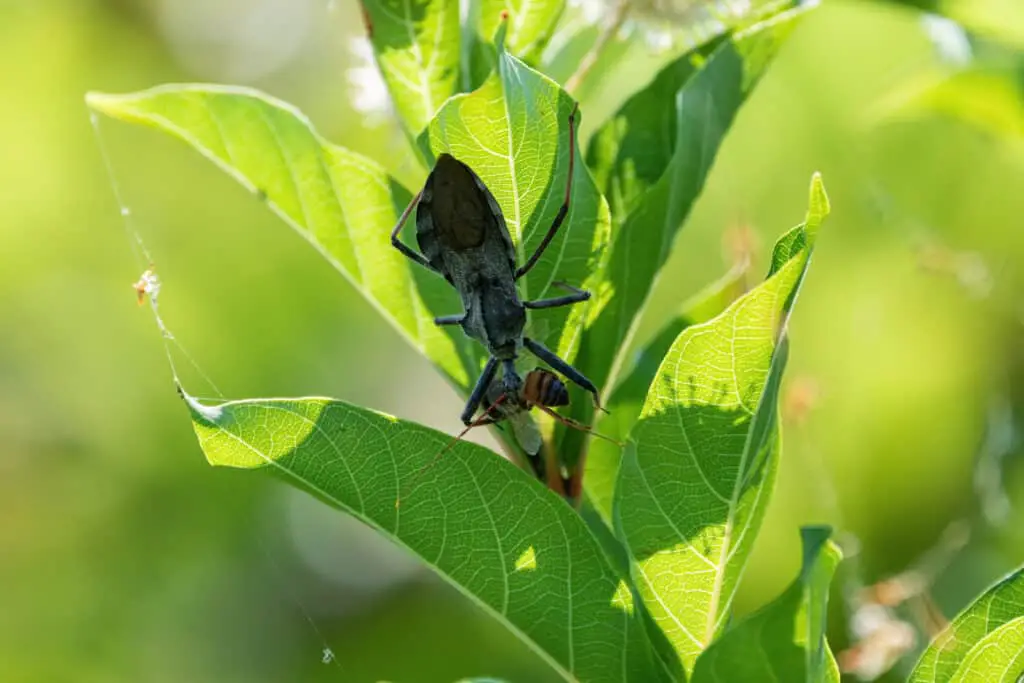
Many individuals fear wheel bugs and try to kill them immediately after seeing them. This is because of their large stature and frightening appearance. They are so large that they are regarded as one of the biggest bugs in the United States, as they are about one inch in length.
Individuals typically feel threatened by wheel bugs even though the bugs do not pose any real threat to them. Because of this, many kill them without thinking twice about it. However, is that really the best option? Are there other alternatives?
You should not kill wheel bugs. Wheel bugs are non-threatening to humans and can even be beneficial. If you find them in your garden, you should be grateful. They will hunt the insects that typically cause harm to your plants, such as caterpillars, beetles, and moths.
Wheel bugs are not fast creatures. They move and fly relatively slowly, making them easy prey to humans. Although they are not difficult to catch, they should be left alone. Killing them is unnecessary as their presence can be helpful. Their appearance is menacing, but they should not be treated as an enemy.
If you want the wheel bugs in your garden to go away, then you should get rid of the insects in your garden. If there are no insects for wheel bugs to feast upon, then they will leave.
How to Get Rid of Wheel Bugs
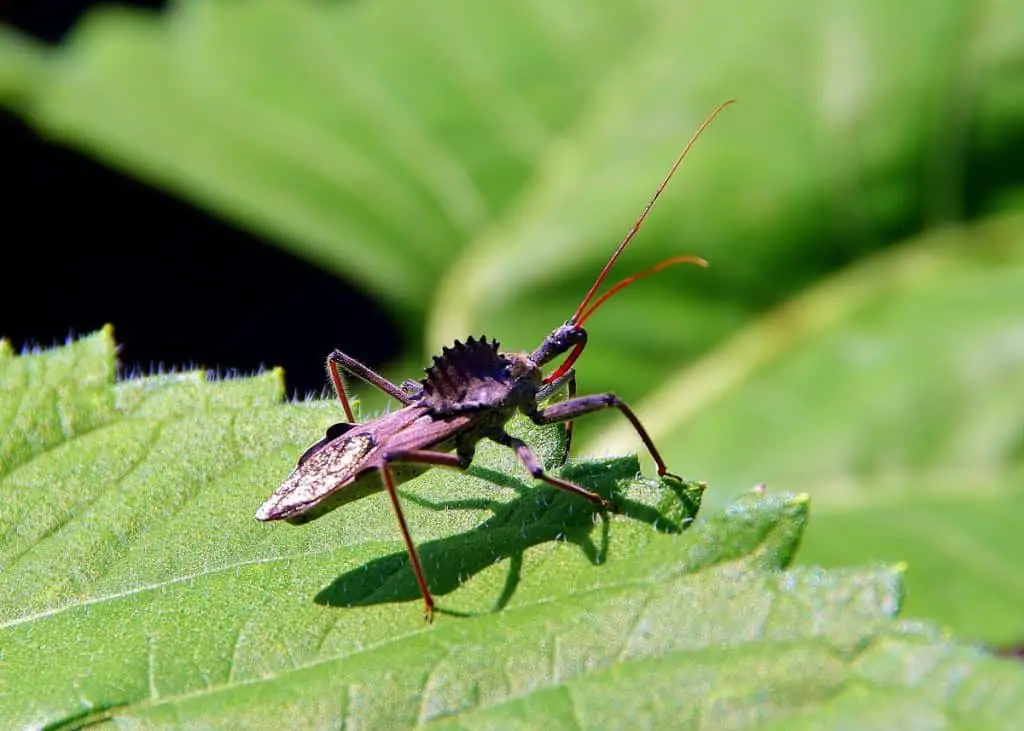
Thankfully, having an infestation of wheel bugs is rare. They do not typically appear in large groups, rather you will only see one or two at a time.
Although they mainly keep to themselves, many individuals still wish to get rid of them. Because you should not kill them, individuals choose to rather eliminate the insects that wheel bugs prey upon so the wheel bugs will leave.
Insecticides should be avoided, as they kill beneficial insects. Most insecticides target all bugs rather than focusing on one, so they should not be used unless in extreme cases.
Insecticides will also kill wheel bugs, which is what you should be trying to avoid. Rather than killing the wheel bugs, simply try and remove their food source so they will leave on their own.
How to Get Rid of Beetles
Beetles are a common food source for wheel bugs. While some beetles are good for plants, others are not. For example, Japanese beetles wreak havoc on gardens. They feed on the plants and cause the plants to die. If you have Japanese beetles in your garden, then you will want to get rid of them as soon as possible.
Trapping
The first way to get rid of beetles is by using beetle traps. These traps do all of the work for you so you do not have to worry about anything. You can find them in the shopping aisles of home improvement stores, or places like amazon (link to beetle traps).
Trapping beetles is one of the easiest ways to get rid of beetles that are in your yard, which is a great start to removing a wheel bug’s favorite food.
Soaping
The second way to kill beetles in your yard is to use insecticidal soap. This soap can be sprayed on bushes, branches, etc to kill the beetles as soon as they land. This is a simple yet effective method.
Drop Cloth & Soap
The third way to get rid of beetles is by using a drop cloth, which is always a great option. Although this method is not as effective as the others, it can still be used to get rid of a large number of beetles. Place a drop cloth down and wait for beetles to crawl on it. Once you notice the cloth is covered in them, pick it up and shake the beetles off into a container filled with soap and water. The soapy water will then kill the beetles.
Neem
The fourth method to get rid of beetles is by using Neem Oil. Spray the oil on branches and bushes that you frequently see beetles on. This will help to reduce feeding and it can even kill some beetles. (link to neem oil pricing) You will have to apply Neem Oil over the course of multiple days, and you must remember to be consistent and frequent.
How to Get Rid of Caterpillars
Wheel bugs feast upon soft-bodied insects such as caterpillars. This is great news for you, as caterpillars are one of the most common insects to cause damage to your plants. Especially if there are many caterpillars in your garden, you will notice the great damage that they cause.
The following methods of getting rid of caterpillars are suggested by Bob Vila, who has had a successful career in home care. Vila was on television for thirty years where he grew and expanded his already flourishing career.
Soapy Water Method
The first way to get rid of caterpillars is by using soapy water. Every time you see a caterpillar in your garden, place them into a container of water and dish soap. Pluck caterpillars from the leaves and drop them into the container. The water and dish soap will then smother them until they drown. Ensure you are wearing gloves while doing this, as some caterpillars will sting you. This method is effective, however, it can take a long time if you have a lot of caterpillars you need to get rid of.
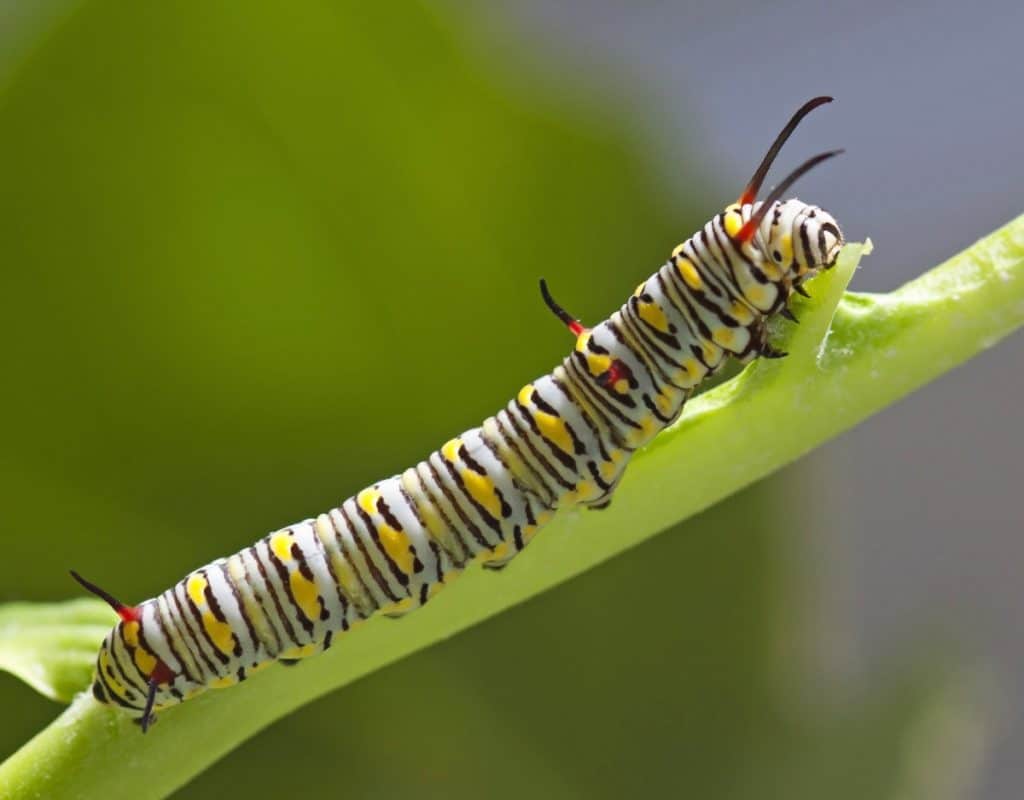
Nest Sabotage
The second way to eliminate caterpillars in your garden is to attack the nest. Use a large wooden stick of some sort and hit the nest hanging from the trees. After the nest has been knocked down, place the entire thing into a container of soapy water. This will kill all of the caterpillars that were still living after the nest got knocked down.
Bacillus Thuringiensis
The third method of getting rid of caterpillars in your garden is by using Bacillus thuringiensis. This type of soil bacteria will only kill caterpillars and a few other harmful garden insects. It is safe for everyone else, including humans and pets. The Bacillus thuringiensis will ruin the lining in the caterpillar’s stomach. Spray this bacteria onto your plants and wait for it to eliminate the caterpillars in your yard.
Home Remedy
The fourth way to lower the number of caterpillars in your garden is by making your own solutions that are non-toxic to humans. A molasses solution is one tablespoon of molasses, one teaspoon of dish soap, and one liter of warm water. Another option is to use a garlic solution: one tablespoon of vegetable oil, three crushed cloves of garlic, one teaspoon of dish soap, and one liter of water. Either one of these solutions will get rid of the caterpillars.
How to Get Rid of Moths
Moths are not innately bad for your garden, however, they will attract wheel bugs. Both moths and wheel bugs can be beneficial for your plants, so you may not want to get rid of them. However, some individuals want to do everything possible to rid their yard of as many bugs as they can, especially scary-looking bugs like wheel bugs.
Soapy Water Dip
The first way you can get rid of moths is by placing them into a container full of water and soap. Leave them in the container for several minutes before removing them.
Tidy Up
The second way to get rid of moths is by keeping your fruit trees neat. If you have any fruit that has fallen off of the tree, clean it up immediately. Nectar allures moths to your garden, and so you will want to get rid of any unnecessary nectar. Certain plants have nectar sources that attract moths to your yard. If you want to get rid of the moths in your garden, try cleaning up the fallen fruit to see if this will help the problem.
Consider Your Lighting
The third method of ridding moths from your garden is by not using lights at night. Moths are attracted to light, so when you keep outdoor lights on at night, they instantly are attracted to them. If you need your lights on, use yellow bulbs. These will repel the moths rather than attracting them.
Wheel bugs are also attracted to light, as they are looking for other insects that are attracted to the light source. Once the wheel bugs have come into contact with these insects, they will kill and eat them.
The fourth way to get rid of moths is by using Bacillus thuringiensis. As mentioned above, this will make moths stop eating and they will eventually starve to death. Spray it onto plants and wait for the moths to ingest it. Once the moths have eaten this bacteria, they will stop eating and the lining of their stomachs will become destroyed.
Conclusion
Wheel bugs are not dangerous creatures and get rid of other pest-like insects in your garden. However, if you are adamant about wheel bugs not being in your garden, the solution is to get rid of their food source rather than killing the wheel bugs.
